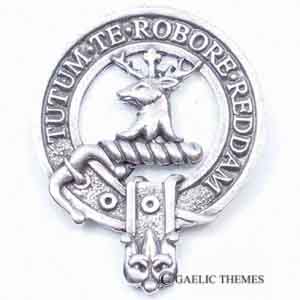Crawford
Select
- Design: Standard
- Clan Motto: Tutum te robore reddam (I will give you safety by strength)
- Notes:
Crest: A stag’s head erased Gules, between the attires a cross crosslet fitchée Sable
The Crawford family is probably of Norman origin -- the name comes from the barony of Crawford in Lanarkshire. Lore states that Reginald, son of the mighty earl of Richmond, was one of the Norman knights established by David I. The Crawfords were part of a legendary incident which led to the founding of Holyrood Abbey. Sir Gregan Crawford was instrumental in saving the king’s life when he was attacked by a stag in 1127.
In 1296, Sir Reginald Crawford was appointed sheriff of Ayr. His sister Margaret married Wallace of Elderslie, and was the mother of William Wallace. The Crawfords rallied to Wallace in his struggles.
Sir Reginald’s line was later styled ‘of Auchinames’ and ‘of Craufurdland’. The chielly line descends from the Auchinames in Renfrewshire who were granted lands by Robert the Bruce in 1320.
A great Scottish soldier, William Crawfurd of Craufurdland was knighted by James I, and fought for Charles VII of France. Fighting for James IV at Flodden, John of Craufurdland perished on that fateful day along with much of the flower of Scottish chivalry. Crawfords of Auchinames also died there and at Pinkie in 1547.
A survivor of Pinkie was Sir Thomas Craufurd of Jordanhill who later became a member of Lord Darnley’s household when he wedded Mary Queen of Scots. In 1669, Thomas denounced Maitland of Lethington and Sir James Balfour as the true conspirators in Lord Darnley’s murder. However, Thomas did not sympathize with Mary’s cause. In 1570, he defeated her forces at Dumbarton Castle with just 150 men.
The twentieth laird of Craufurdland Castle, John Walkinshaw Craufurd, was a prominent Lieutenant Colonel in the Hanoverian army who served with distinction at both Dettingen in 1743 and Fontenoy in 1745. Despite his position, John was close friends with the Jacobite Earl of Kilmarnock. When Kilmarnock was beheaded, John accompanied his friend to the scaffold. He received the severed head and also attended the funeral. This act of chivalry and charity caused Craufurd’s name to be dropped to last-of-list in the army. In 1761, his fortunes rose when he was appointed falconer ot the king.
Another famous Crawford was Robert Craufurd of Kilbirnie who commanded the Light Division in the Peninsular War (1808-14). Robert died in 1812 leading an assault on the fortress of Ciudad Rodrigo. He is remembered by a monument in St. Paul’s.
